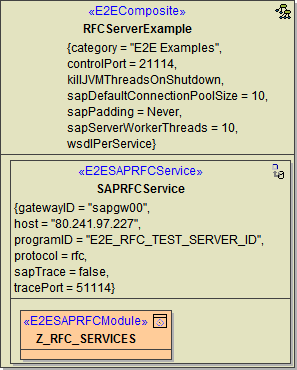- Created by Kirstin Seidel-Gebert, last modified by Annegret Bernhardt on Jan 29, 2024
This is example shows how SAP calls remotely a function module running on the Bridge. This function module takes two numbers and returns their sum.
Figure: RFC Service Use Case

Implementing RFC Operations
The following example just adds two numbers. The only feature of this activity diagram being specific to SAP are the import and export parameters and the fact that is assigned to an operation of a <<SAPRFCModule>> class. These properties make this activity diagram callable from SAP systems. The only constraints on such activity diagrams are that their interface is restricted to import, export, changing and tables parameters (see RFC Arguments).
Figure: Implementation of SAP RFC operation

The following classes give the import and export arguments:

Defining RFC input- and output arguments are the same as for clients and are explained in chapter RFC Arguments.
RFC Service Components
In order to build a Bridge SAP RFC Server, the following components must be defined:
- The xUML composite RFCServerExample holding all services you want to deploy.
- Within the composite there are one or more SAP RFC services having the stereotype <<E2ESAPRFCService>>. In the current simple example it is the SAPRFCService.
- Each service holds one or more classes with stereotype <<E2ESAPRFCModule>> that define the interface of the service. The activity diagrams assigned to the class operations define the implementation of the operations. In our example, the activity diagram Z_RFC_ADD implements the operation Z_RFC_ADD of the class. Z_RFC_SERVICES. Z_RFC_ADD is also the function name used within SAP ABAP programs to call the operation Z_RFC_ADD. See also the comment attached to the Z_RFC_ADD operation.
Builder 6 Modeling RFC services follows the same rules as modeling tRFC servers with two exceptions: the protocol tagged value must be rfc and there exists no <<SAPTRFCCallback>> interface.
Figure: RFC Service Components

The RFCService has the following tagged values:
| Tagged Value | Description | Mandatory/Optional |
|---|---|---|
| <<E2EComposite>> | ||
| sapDefaultConnectionPoolSize | Default capacity of a single SAP connection pool (Bridge acting as a SAP client). If undefined, a default of 10 connections will be applied. Each distinct connection to a SAP system has its own pool. Connections are distinguished by the set of connection parameters (connection string). You can override the connection pool size for a specific connection on the corresponding SAP alias. On using dynamic SAP access, the default connection pool size is used. | optional |
| sapPadding | Service-wide setting for SAP values padding. This setting will be applied to all IDoc and SAP adapters within the service. It is not recommended to use Mixed padding. This option is only available for reasons of backwards compatibility. Mixed padding is default for older services that have been compiled before the implementation of this tagged value, whereas Never is default, if no SAP padding is specified. | optional |
| sapServerWorkerThreads | Number of parallel request (workers) the Bridge (acting as an RFC server) can process. If this value is undefined, the Bridge will only process one request at a time (equivalent to sapServerWorkerThreads=1). Each active worker requires one license slot (concurrent connection). For more information on licensing and concurrent connections, refer to License for Running xUML Services. | optional |
| <<E2ESAPRFCService>> | ||
| host | Optional gateway host name. Default is localhost. | optional |
| gatewayID | The port number of the SAP gateway. | mandatory |
| programID | The programID to which the service is registered on the gateway. | mandatory |
| protocol | Must be trfc when using the tRFC protocol. Must be rfc when using the RFC protocol. | mandatory |
| sapTrace | The effect of this flag being true is two fold: First, the SAP RFC libraries will write trace file information (.trc) into the directory the configuration has been deployed to. Second, by using the SAP transaction *SMGW (SAP gateway monitor) we can monitor the dataflow from and to the gateway the server is registered on. | optional |
| tracePort | The same operations that are called by the SAP system can also be called by SOAP test tool. However, the SOAP test tool requires an HTTP TCP/IP port. This port can be defined in the tracePort tagged value. If this value is not set, the trace port is given by controlPort + 50000. | optional |
On the composite, you can also set a service-wide SAP value padding: Never, Always and Mixed. See Frontend Components for more information.
Example of an ABAP Function
The following example ABAP function (Z_CALL_RFC_SERVER) calls the Z_RFC_ADD Bridge operation by using the following ABAP code:
FUNCTION Z_CALL_RFC_SERVER.
*"----------------------------------------------------------------------
*"Local interface:
*" IMPORTING
*" VALUE(IP_VALUE1) TYPE I DEFAULT 0
*" VALUE(IP_VALUE2) TYPE I DEFAULT 0
*" EXPORTING
*" VALUE(EP_SUM) TYPE I
*"----------------------------------------------------------------------
DATA: EP_RESULT TYPE i VALUE 0.
CALL FUNCTION 'Z_RFC_ADD'
DESTINATION 'E2E_RFC_TEST_SERVER2'
EXPORTING IP_INT1 = IP_VALUE1
IP_INT2 = IP_VALUE2
IMPORTING EP_RESULT = EP_SUM.
ENDFUNCTION